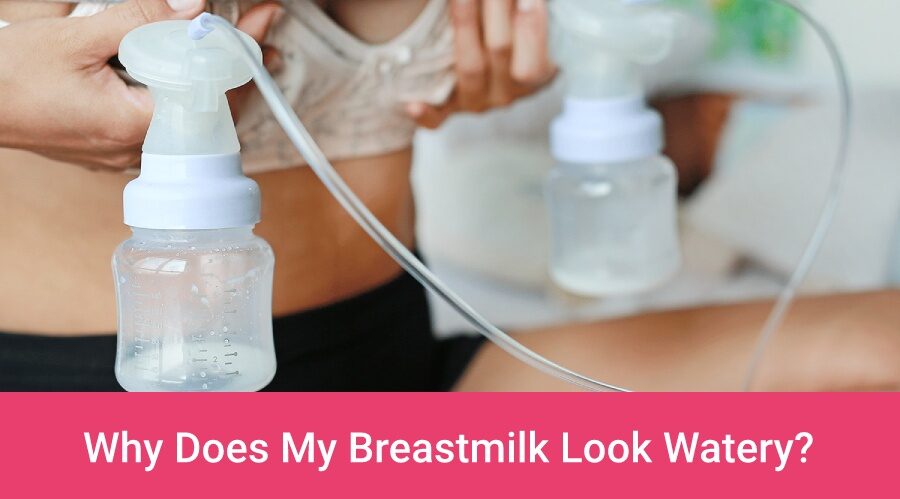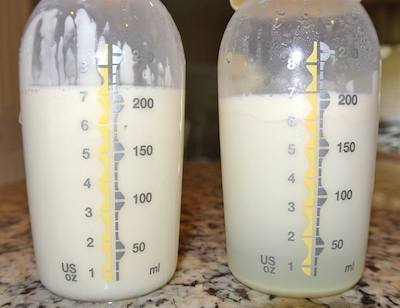Are you concerned because your breastmilk looks watery? In this article Medical Doctor explains if this is if thin and watery breastmilk means lower quality and less nutrients for your baby!

Article By Edna Skopljak – Medical Doctor (MD)
Breastfeeding is the most valuable gift you can give to your baby. However, it can sometimes be stressful and cause concerns for (especially newborn’s) moms.
Breast milk’s nutritional content changes and adapts to your baby’s needs. Sometimes, when breastfeeding moms notice more watery milk, which is thinner than usual – they get worried. Some moms, unfortunately, for that reason, stop breastfeeding.
But – there is nothing to worry about! It is perfectly normal and expected to experience watery milk sometimes.
Watery breast milk may make you wonder whether your breast milk has enough milk and contains enough fat and calories.
Breast milk volume and look are not merely indicators that your baby is or is not well-fed. You should also rely on other signs, including the baby’s weight gain and the number of wet diapers during the day.
In this article, I will try to explain “the science behind” breast milk and, hopefully, comfort your breastfeeding worries.
This article is not a substitute for medical advice or consultation.
How Does Watery Breast Milk Look Like?
When you are breastfeeding, it can sometimes be challenging to assess whether your milk looks watery or creamier.
If you are pumping, however, you can occasionally notice that your pumped milk seems a little too thin and more transparent than you would expect.
Furthermore, if you leave your milk to sit after the pumping session, you may notice that the higher fat hindmilk floats to the top and that there is a lot of clearer, watery part on the bottom of the bottle.
The watery milk looks exactly like the name implies – thin and watery, with paler white or even bluish color, like skim milk. It reflects the fat content of breast milk1.

Understanding Breast Milk
Breast milk is a liquid gold made in the breasts directly from the mother’s blood. It is a living substance. Breast milk changes and adapts to your baby’s needs (and during each feed!). And it has a complex composition.
Breast milk contains watery foremilk and higher fat hindmilk. Foremilk and hindmilk, however, are not two distinct types of milk.
The low-fat milk stored in the front, near the nipple, comes first during the feeding session. The creamier, fatty milk being in the back, comes after as the feeding progresses.
Don’t worry. Your breasts produce just the right amount of both! And your baby drinks enough of both, as long as you breastfeed on demand and/or use a breast pump for long enough.
Foremilk And Hindmilk – Differences
So, we now know that your breast milk consists of foremilk and hindmilk2.
Foremilk is that watery milk which flows out first. It is lower in fat but is rich in water and lactose (milk sugars). Therefore, the foremilk helps your baby stay hydrated and provides the nutrients and calories that little one needs. And although it looks thin and watery, it is essential for your baby’s nutrition and hydration.
On the other side, hindmilk is fatty milk that is expressed after the foremilk toward the end of the feeding. Its color is more opaque, and it looks heavier and thicker. The hindmilk is rich in nutrients and calories, so this part of the breast milk fills your baby up and keeps them satiated.

What Causes Watery Breast Milk?
Here are the most common reasons for breast milk to look watery3.
Switching Sides Too Early
With your best intentions to make your baby have enough milk during the feeding session, you may think that switching sides from one breast to another will be beneficial for breastfeeding effectively.
However, if you switch the baby to another breast before emptying the first, your little one will not get enough hindmilk from the first breast. Furthermore, their stomach may become full of lactose rich foremilk before the end of the feeding session on the other side.
In the end, the baby gets too much foremilk from both breasts, but little or no hindmilk.
Short Pumping Sessions
Breast pumping is actually very similar to breastfeeding. And quick pumping sessions on one breast have the same effects, as switching sides too early during breastfeeding.
Short pumping time will relieve the pressure in your breasts, but you will not produce enough of the more fatty milk your baby needs. And it is exactly what can make your breastmilk watery.
Long Breaks Between Nursing
If you, for any reason delay feeding, your breasts will continue to fill. Although the periods between two nursing sessions prolong, your milk supply still increases.
And, if they produce more breast milk than your baby can take in one feeding session, their stomach will get full and they will stop feeding before they get that mature milk. And yes, this can lead to lactose overload.
High Breast Milk Production
While there are those breastfeeding moms who struggle with the milk supply, there are also those moms who have more milk than usual. But, before you envy those moms, know that excessive milk production can bring troubles, too!
Due to the oversupply, the breasts fill up sooner and are more difficult to empty for the baby. And, again – they end up with plenty of the first milk without getting enough high fat milk.

Is Watery Breast Milk Safe For Babies?
Absolutely. Watery milk is totally safe for breastfed babies. Moreover, it is important for them to get enough foremilk.
You may wonder what could possibly make watery breast milk good for your little one. Firstly, foremilk hydrates your baby. Secondly, it has higher lactose content. Lactose supports your little one’s development and provides them with energy.
So, watery breast milk is both safe and necessary for your baby to drink! However, make sure that the baby gets enough of the whiter milk, as it contains fats, and prevents lactose overload.
Is Watery Breast Milk Less Quality & Less Nutritious?
No, watery milk is not less quality or less nutritious. It merely contains different components than the higher fat milk which follows the watery milk.
Foremilk is, therefore, important for your baby’s nutrition, as much as hindmilk – creamier milk is. It is important for your little one to get enough of both.
However, if your baby has trouble gaining weight, doesn’t have enough wet diapers during the 24h, or experiences change in bowel movements and gastrointestinal discomfort, you may be facing hindmilk imbalance.
How Do I Make My Breast Milk Less Watery?
We already discussed what can make your breast milk watery. So, the solution is to prevent or treat the causes. Sounds reasonable, right?
1. Allow Your Baby To Stay On One Breast For Long Enough
Rule number one: Let your baby decide when they’re done with eating. Try to keep them on one breast for as long as they eat (and as long as possible), to ensure they get enough of higher fat content at the end of the feeding session.
2. Prolong Your Pumping Session
The same applies to pumping. Try to pump the breast milk as long as possible, making sure that one breast is entirely empty before you remove the pump.
If the pumped breast milk looks watery, clear, too transparent, or blueish, keep pumping for another few minutes, until you come to that mature milk.
3. Make Breastfeeding Sessions More Frequent
As the milk ducts fill with milk, more watery breast milk builds up in the front of the breasts, so there is too much light milk for babies to eat before they get to hindmilk.
Breastfeeding or breast pumping more often gives your milk ducts less time to produce milk, and consequently, less milk will be built – and the hindmilk will be released sooner.
4. Control Breastmilk Overproduction
If you are overproducing breastmilk, you should correct it – and control it. Consider asking a lactation consultant for help in figuring out the reason behind the overproduction.
While great amounts of breastmilk sound good, if your baby can’t keep up with the amount your breasts produce, it can cause trouble.

Thin & Watery Breast Milk – FAQ
As a worried mom, you surely have many questions about why is their breast milk watery.
You want to make sure your baby is well-fed, is gaining weight4, has enough wet diapers during the day, and – that your breast milk ensures all of it. Right?
Therefore, I will answer some frequently asked questions about that.
Should I Throw Away Foremilk?
No, do not throw away the foremilk. It is equally important for breastfed babies to get enough of the water and lactose in the foremilk, as the fat content in the hindmilk. Besides, foremilk contains nutrients and calories, too.
How To Make Sure Your Baby Gets Enough Foremilk And Hindmilk?
Follow the simple steps to ensure your baby gets just the right amounts of both the foremilk and hindmilk. First of all, take it slow with the feeding and pumping sessions.
Don’t rush to change sides. Also, increase the frequency of breastfeeding to avoid oversupply. And, control and correct the overproduction of breastmilk.
What Happens If Your Baby Gets Too Much Watery Milk?
If your baby gets too much foremilk, it can lead to lactose overload. That can cause trouble for your little one to gain weight, cause issues with the gastrointestinal system, and lead to changes in the baby’s stool.
Also, if your baby has lactose intolerance, these problems will be even more pronounced. Ask a lactation consultant for help if you notice your baby has any of the mentioned problems.
Does Pumping Make Breast Milk Watery?
Pumping itself does not make your breast milk watery. However, the pumping sessions being too short will cause worries for most moms, as they will probably see watery, transparent breast milk in the bottle and wonder if that milk is nutritious enough – or is even low in quality.
Does Mother’s Diet Cause Watery Milk?
One of the breastfeeding myths is that mom’s diet affects breast milk. Rest assured: Breast milk is not made directly from the food you eat5.
Breast milk contains nutrients, antibodies, stem cells, food for healthy gut bacteria, and other useful ingredients. These do not change with an individual’s diet.
However, make sure you have a healthy diet to ensure your baby receives all the nutrients they need to grow and be healthy – but also to care for your own health and energy reserves.
What Makes Breastmilk More Fatty?
In order to achieve thicker and fattier breast milk, make sure you follow the simple steps for effective breastfeeding, or breast pumping, written in this article.
Ensure the lengths of the feeding/pumping sessions are long and frequent enough. If you have any additional concerns, talk to the lactation specialist.
Make your breastfeeding experience as carefree as possible. It will not last forever, and all your worries will pass. Newborns become infants very soon. They grow up so fast!
Article By Edna Skopljak
Edna Skopljak is Medical Doctor (MD) who works in University Medical Centre in Ljubljana. She’s a She also worked as an editor at BJBMS medical journal for several years. She wrote content for several health-related websites and the BJBMS blog. She’s a mom of a 15-month-old.
The purpose of this article is informative. It’s not a substitute for professional medical advice or medical care. Remember: safety first! Consult your doctor/pediatrician in case of any doubts. The author of this article does not accept any responsibility for any liability, loss or risk, personal or otherwise, incurred as a consequence, directly or indirectly, from any information or advice contained here.
Resources:
https://milkology.org/
https://kellymom.com/
https://www.laleche.org.uk/
https://www.romper.com/
https://exclusivepumping.com/
http://dairyqueenstheblog.blogspot.com

